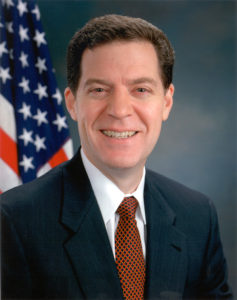Gov. Sam Brownback agrees with the Kansas Supreme Court, he said in a statement issued March 1.

The Supreme Court ruled current school funding unconstitutional on March 1 and gave legislators a June 30 deadline to develop a new funding formula.
“The Kansas Supreme Court correctly observes that our education system has failed to provide a suitable education for the lowest performing 25 percent of students,” Brownback said. “The old funding formula failed our students, particularly those that struggle most.”
Graduation Rates
Senate Education Committee Chair Sen. Molly Baumgardner said only 86 percent of Kansas students graduate from high school, and only 65 percent of those attend college.
Baumgardner, R-Louisburg, said her committee spent the first six weeks of the legislative session studying parts of the old formula and focusing on what’s happening in Kansas community colleges.
She said, “39 percent of our freshman just out of high school are needing to take remedial courses. What some people are surprised at is Johnson County Community College where 58 percent of students that just graduated from high school are needing to take at least one remedial course.”
Students at Kansas’ 19 four-year colleges fare slightly better where only 15 percent of recent high school graduates need to take remedial courses.
“We already know most of them aren’t college ready,” Baumgardner said.
K-12 Inadequacies
The Supreme Court decision called K-12 school funding inadequate. Justices cited recent test scores revealing that almost half of African-American students and a third of Hispanic students fail to meet proficiency standards.
A new funding system must right that wrong, Brownback said.
“The Kansas Legislature has the opportunity to engage in transformative educational reform by passing a school funding system that puts students first,” he said. “Success is not measured in dollars spent, but in higher student performance.”
Funding Mechanisms
The Court opinion stopped short of saying the legislature must spend a certain amount of money to meet constitutional muster, though the Kansas Department of Education officials and lawyers for the four school districts that sued have offered cost estimates for adequacy. KSDE officials estimated it would cost the state more than $535 million, while plaintiffs’ attorneys estimated a figure of more than $800 million in new funding.
Getting a majority of legislators and school districts to agree to a new funding formula that doesn’t add dollars to the bottom line may be a challenge. Though the Court ruled unconstitutional block grants set to expire on June 30, Baumgardner said there are 181 school districts who prefer the block grants.
“It’s because they have 3,500 fewer students than they did when we started the block grants, and they are receiving funding for students they don’t have anymore,” the Louisburg Republican said.
The trick will be redirecting funding to growing schools, according to Baumgardner. She listed Gardner-Edgerton and the Spring Hill School Districts as examples.
“They’ve had double-digit percentage population increases, and they’ve been frozen as far as funding,” she said.
Legislators scrapped an old funding formula in 2014 and replaced it with block grants, based on districts’ existing funding. That funding mechanism expires on June 30 this year, the court-mandated deadline for adoption of a new formula.
Dollars Following Students?
Kansas Policy Institute President Dave Trabert called the Court’s opinion “encouraging.”
“With the block grants never intended to be a long term solution, today’s ruling isn’t all that surprising nor does it change the dynamic through the rest of the 2017 legislative session,” Trabert said.
The old formula focused on dollar amounts, but didn’t consider educational outcomes, according to Baumgardner. She worried the legislature now is focused on an idea that simply hiring more teachers will solve the educational outcome issue.
“It won’t,” she said. “A lot of extra funding has gone to more teachers to reduce classroom size, but not for specialized reading teachers or math intervention teachers. And you still have kids that need that special, individualized attention,” she said.
The focus now should shift to how money reaches specific students–and not how it gets to the schools, she explained.
It’s a theme echoed in the Governor’s response to the Supreme Court decision.
“…The time has come to equip parents of struggling students with the power they need to determine the best education for their child,” Brownback said “If they believe a quality education is not possible in their local public school, they should be given the opportunity and resources to set their child up for success through other educational choices.”

